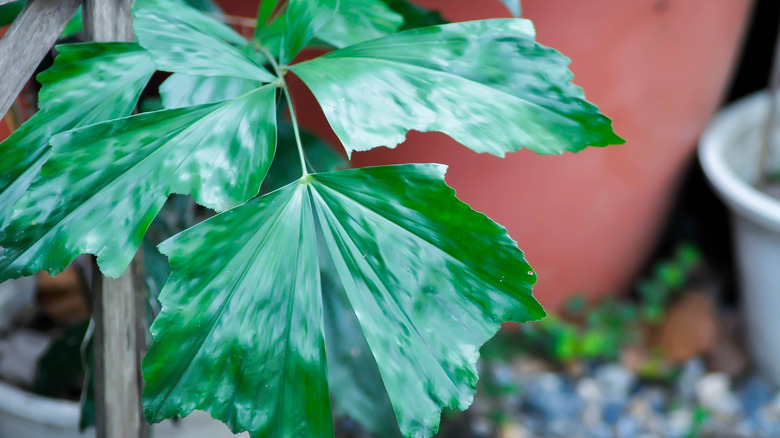The Palm Variety That Thrives In Full Sun Areas Of Your Home
Finding the right houseplant for different areas of your home can be difficult. There are many factors to consider — size, light needs, and reachability by children and pets, to name a few. While palms don't make sense for every garden since they're not especially cold tolerant, they can be great houseplants, and they come in many varieties. The fishtail palm (Caryota mitis) is a perfect fit for the sunnier areas of your home, and it makes for a great statement houseplant, even if you don't have a green thumb.
The fishtail palm gets its name from its feathery, bipinnate fronds, which resemble fish tails. As an outdoor plant, fishtail palms are frequently used as screens, offering a more manageable alternative to bamboo, which is difficult to remove once planted. When kept as an indoor plant, the fishtail palm serves as a beautiful ornament, though its size and need for sunlight might not suit every area of your home. If you've got adequately sunny spots in your home, the fishtail palm might be exactly the kind of low-maintenance tropical plant you're looking for.
Fishtail palms love sunlight and humidity
Though fishtail palms have unique fronds, they are still palm trees and require many of the same things as other palms. Native to Asia, northern Australia, and the South Pacific, fishtail palms prefer low to medium humidity in their environment, and their shallow roots like rich soil. As indoor plants, they are susceptible to spider mites and scale, so keep an eye out for any white spots on the underside of their leaves. Though they can tolerate partial shade and dappled sunlight, fishtail palms also thrive in full sun, where they receive at least six hours of direct sunlight throughout the day.
When watering palm trees, be careful not to soak the plant too much. The fishtail palm dislikes overly wet roots, so make sure its container drains well. Unfortunately, the fishtail palm is a monocarpic plant — once a stem completes the flowering stage, it dies. Luckily, your fishtail palm is a clustering palm made up of more than one stem, and the plant's flowering period can last up to seven years, so you'll have plenty of time with it.
Keep in mind the fishtail palm's size
If you're looking for an indoor plant to fill out space in a large planter, the fishtail palm could be a great fit, but you should be mindful that it has the potential to reach 25 feet in height if left to grow unchecked. To keep your palm from tickling your ceiling, you can prune it, removing brown fronds and spent flower stalks but not green fronds. Still, there may come a time when your fishtail palm is too large for your home.
Make sure children and pets do not have access to your fishtail palm, as the plant's fleshy berries are toxic. While the seeds are considered delicacies, consumption of the mature fruit can cause swelling, burning, and redness, as well as severe pain. Even in adults, handling the fruit may cause dermatitis, so avoid contact with the fruit, especially if it has been split or crushed. No other parts of the plant are toxic, so you don't need to worry about gloves when touching the stem or leaves.


